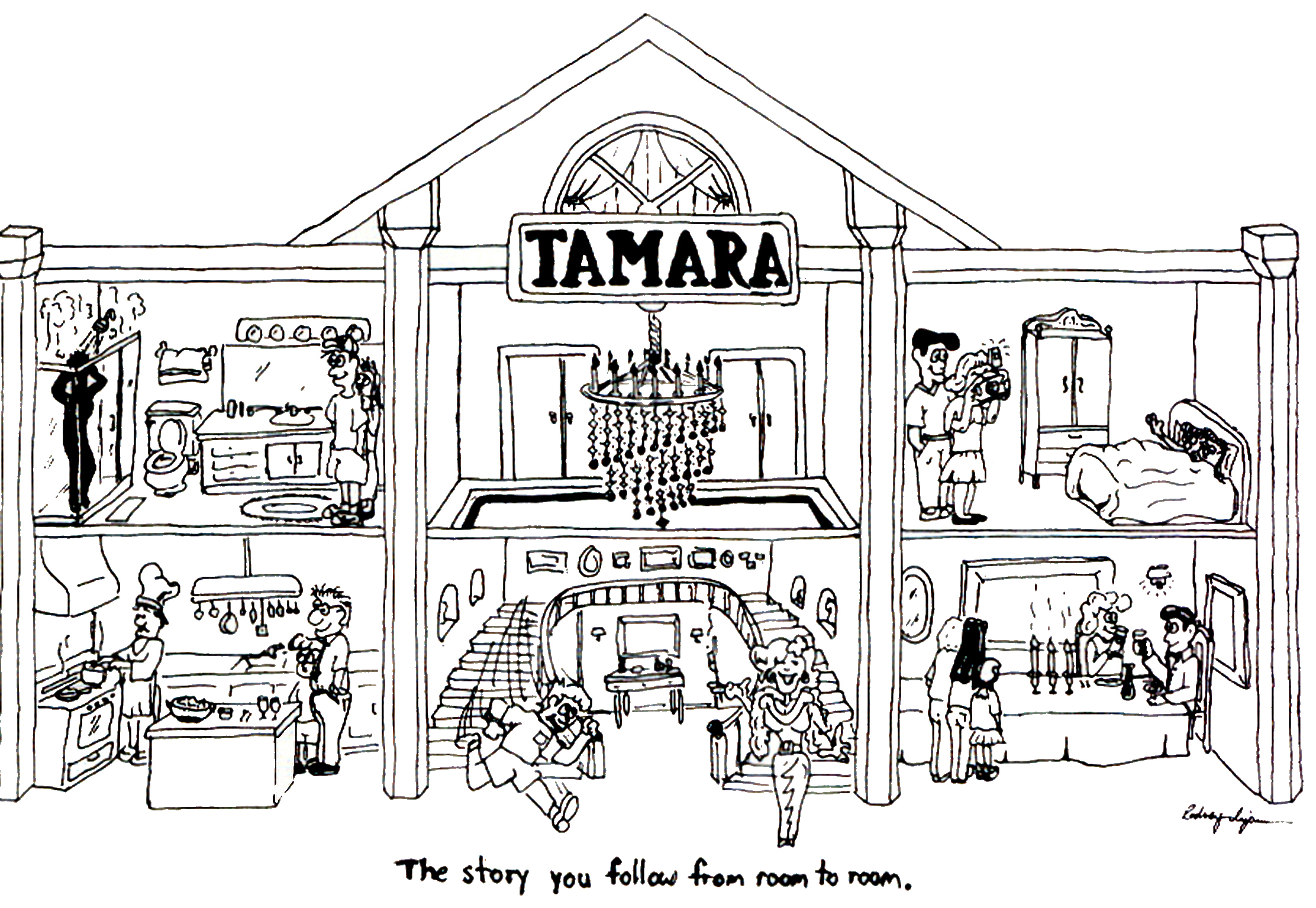
Why you need to do antenarrative self-reflection? Because you cannot be in every room at once in an organization with more that two rooms.. In an organization with just 6 rooms, there are six factorial path ways of networking, a choice of 740 paths, and you are choosing only a few. People arrive at the same room form different path routes. So what? The people in same room, get different meaning inference from waht they see and hear going on. If it is a 12 room organization, that is 12 factorial, 479,001,600 route pathways to get from one place to another. You chase stories all day long, and cannot be in very room at once. You are making abductive guesses, hunches, wild intuitive guesses on what is going on, becuase you are in pre-story and pre-narrative mdoe.
In John Krizanc's original Play (Tamara), people are in a mansion, and get a 1927 passport. He wants them not just to be entertained, but to chase stories, and characters, who keep changing the story. Why? To experience Mussolini fascism., with spies part of Mussolini black shirts, and spies for the resistance. Characters change their spin, from one room to the next.
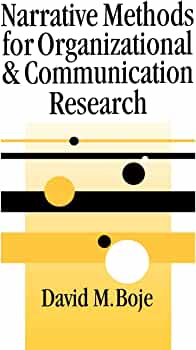
Antenarrative is a
word I invented in the 2001 book, Narrative Methods for
Organizational & Communication Research to get at
process dynamics of organizational storytelling. First,
ANTE (is short for antecedent, what comes BEFORE). Second,
ANTE means a BET. It in the 2001 book as
'BEFORE-narrative' and a 'BET on the future.' Now there
are 7 B's I will introduce to you.
LOOK
INSIDE:Read 2001 Introduction to my book
then you will know the complete answer!
"Antenarrative is defined as ‘the fragmented,
non-linear, incoherent, collective, unplotted, and
pre-narrative speculation, a bet, a proper narrative
can be constituted’" (Boje, 2001: 1).
Antenarrative is seven
processes that are pre-constitutive of 'narrative'
and 'living story'. The 7 B's: Beneath,
Bets, Before, Being, Becoming, Between, &
Beyond. The 7 came after 20 years of
investigation.
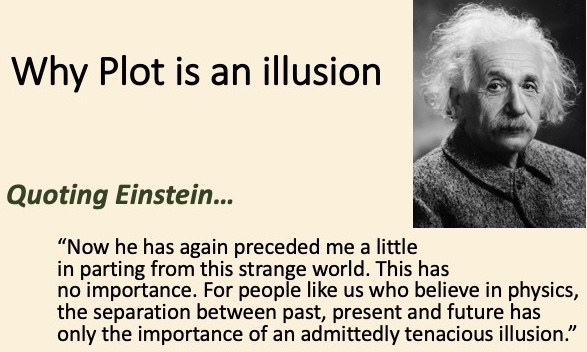 nd Beyond.
nd Beyond.
- Beneath: This process goes beyond the surface level of narratives to examine the underlying assumptions, power dynamics, and material realities that shape stories. It involves looking at the microstoria of marginalized people and the material intertextualities that often get ignored in dominant narratives. For example, in the case of Haute Cuisine, the "beneath" involves examining the impact of fast food on traditional culinary practices and the shift in consumer preferences that is driving this change.
- Before: This process recognizes that the past is not static but is constantly being reinterpreted and reshaped in light of the present and future. It involves considering the historical context and the antecedent events that have led up to the current situation. In the context of entrepreneurship, understanding the "before" of an entrepreneur's journey can shed light on their motivations, experiences, and the factors that have shaped their venture.
- Bets: This process acknowledges that the future is uncertain and that innovation and entrepreneurship involve making calculated risks. These "bets" are based on prospective sensemaking, anticipating future possibilities and making decisions based on these projections. Analyzing these bets helps understand the decision-making process and the factors that influence entrepreneurial choices.
- Between: This process focuses on the relationships and interactions between various elements in the storytelling process. This includes the interplay between living stories and dominant narratives, the influence of different stakeholders, and the role of sociomaterial artifacts in shaping creative work. Understanding these "between" dynamics provides a more nuanced and contextual understanding of how stories are constructed and how they influence actions and outcomes.
- Becoming: This process emphasizes the dynamic and emergent nature of storytelling, recognizing that stories are constantly evolving and being reshaped. "Becoming" highlights the continuous process of change and adaptation that characterizes innovation and entrepreneurship, as new ideas emerge, trends shift, and possibilities unfold.
- Beyond: This process encourages a broader perspective, considering the long-term implications and the ethical dimensions of storytelling. It involves thinking beyond immediate goals and profits to consider the impact of innovation and entrepreneurship on society, the environment, and future generations. This includes reflecting on the values and principles that guide innovation and ensuring that it contributes to a sustainable and equitable future.
- Being: This process explores the fundamental questions of identity, purpose, and existence in relation to storytelling. It involves examining the underlying assumptions and beliefs that shape our understanding of the world and our place within it. In the context of innovation and entrepreneurship, "being" prompts reflection on the motivations, values, and aspirations that drive these endeavors and their impact on individuals and society.
These seven antenarrative storytelling processes offer a comprehensive framework for analyzing and understanding the complexities of storytelling in various contexts, including innovation, entrepreneurship, and long-range planning. They highlight the importance of looking beyond traditional linear narratives and considering the multifaceted and dynamic nature of stories and their impact on individual and collective actions.
Short version of 7 B's of Antenarrative-Storytelling-Processes
Beneath: Examining underlying assumptions and the material world.
Before: Recognizing the influence of past events and their reinterpretations.
Bets: Exploring various possibilities and making choices about the future.
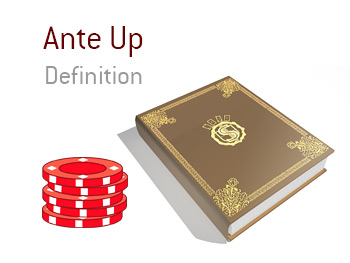
Ante-up is a poker term - An "ante" is an amount of money that each player in a game has to pay before every hand. You will have the "blinds", the "straddle" (if the game is using a straddle) and an "ante" - in all three cases, impacted players will need to contribute money to the pot. With the ante, each player at the table needs to contribute the same amount before the hand takes place. Guess what? Organizations play the game of Ante-Up, in their world-making strategies.
Being: Acknowledging the existential reality and its interplay with "becoming."
Antenarrative Storytelling Processes and Long-Range Planning.
Becoming: Embracing the constant change and evolution of situations.
Between: Understanding the interplay of individual, social, corporate, and ecological factors.
Beyond: Grounding actions in a sense of responsibility and sustainability.
Media
Click here to Watch short YouTube on why Antes are seeds of storytelling.
Click to hear 14 minute podcast audio
Click to hear Podcast on Anti-narrative and Ante-narrative
Key Concepts:
- Beneath-antenarrative: The underlying forces shaping organizational pre-narratives
- Before-antenarrative: The pre-story state of retrospective sensemaking of organizational experience
- Bet-antenarrrative: The bets on the future (ante-up in
poker), prospective sensemaking
- Being-antenarrative - The spacetimemattering of vibrant mattering
- Becoming-antenarrative: The emergent nature of organizational storytelling
- Between-antenarrative: The spaces where multiple stories intersect
- Beyond-antenarrative: The aliveness of the cosmos, the
planet, and all species. Beyond is posthumanist.
See
List of 70 Recent Antenarrative Publications
| Return to
ANTEnarrative home page |
Professor David Michael Boje (2001)pioneered
“ANTEnarrative-Storytelling-Processes” (ASP) framework which
he uses to analyze, the seeds of storytelling. Boje's
ANTEnarrative-Storytelling-Processes (ASP) framework examines
the hidden narratives and assumptions underlying and
constitutive of Project 2025’s narratives by using seven “B”
words: Beneath, Before, Bets, Being, Becoming, Between, and
Beyond. Through this 7 B's lens, the Boje analyzes what he
calls the seeds of pre-story and pre-narrative, how they get
constituted
Explore the latest research and thinking in antenarrative
theory and methodology. Our work spans organizational studies,
storytelling, and narrative analysis. This book is most
uptodate treatment of antenarratives, the seeds of
storytelling.
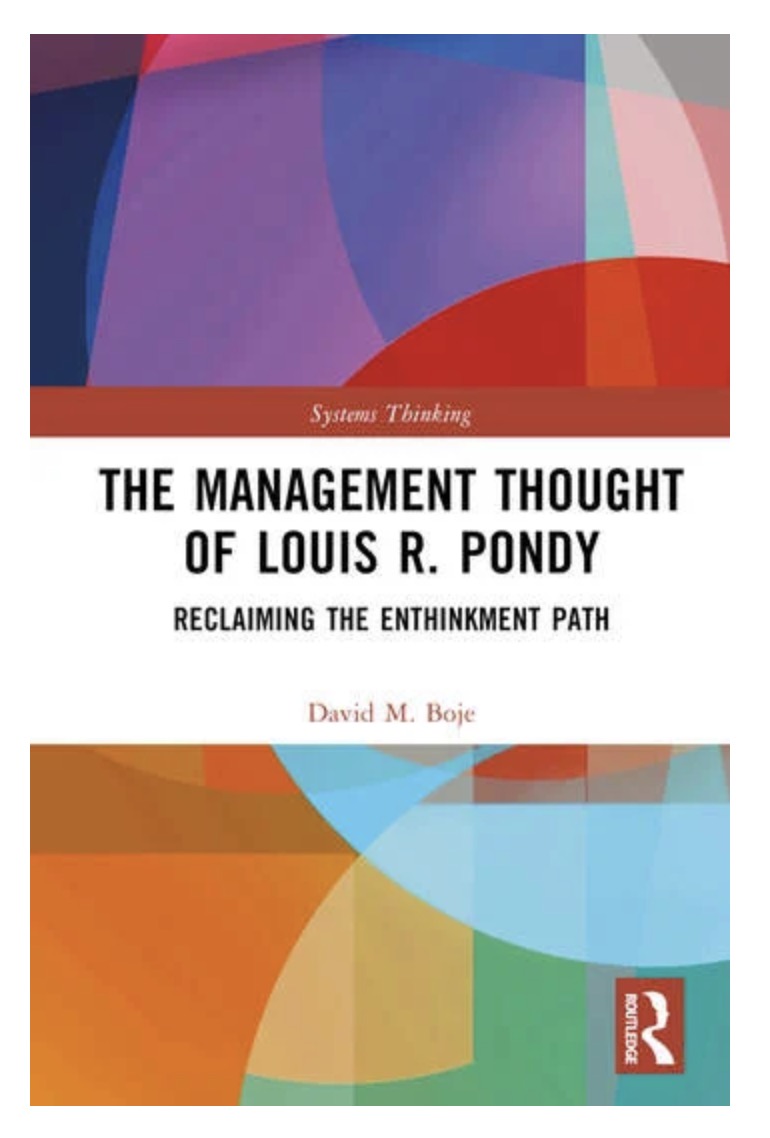
Co-authored with Rohny Saylors
Buy it on Amazon
Slide presentation
How to use Antenarrative in Deconstructing Grand Narratives?
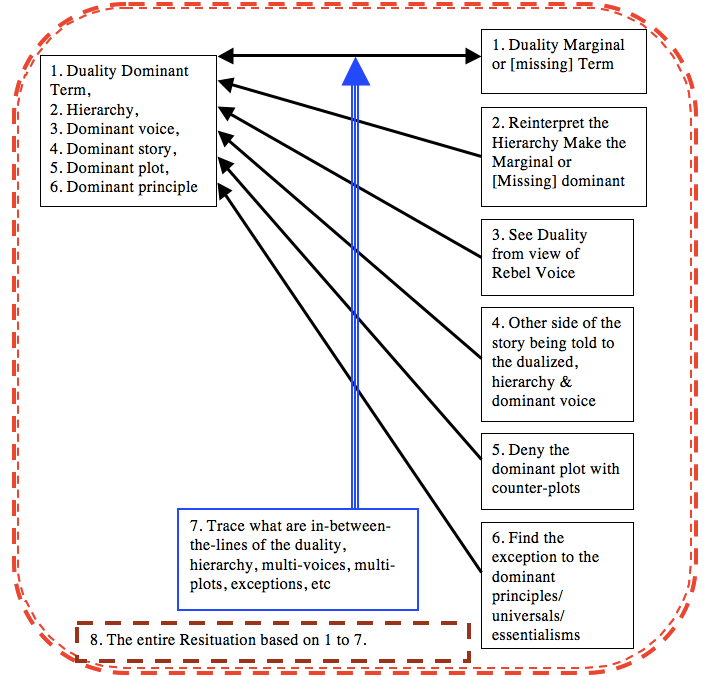
Source: Adapted from Boje, 2001 Narrative Methods... book
Disclaimer: Derrida does not do steps, its more a style. I know to provide you steps is a violation.
Step 1: Duality Search of the BENEATH, those Grand Narrative Claims to a Regime of Truth.
Step 2: Reinterpret Hierarchy of the Duality with Marginals, already there in potentiality in the BEFORE.
Step 3: See Duality from the view of Rebel voice's (BETS--on-the-Future).
Step 4: What are Other Sides of The (polyphonic) Story in process of BECOMING?
Step 5: Deny the Dominant Narrative's Plot with Counter-Plots, of Other Stakeholder's (BETS-on-the-Future)
Step 6: Going into BENEATH what grand narrative declares True to all that was edited out of what Foucault calls the Regime of Truth.
Step 7: Welcome to the BETWEEN, the Unspoken, in the Silence of the Artifacts, and Material-Discursive (see Karen Barad, Donna Haraway, Myra J. Hird, & Jane Bennett)
Step 8: Resituation to effect change in the status quo by Going into the BEYOND.
How to interplay Antenarrative, Anti-narrative, Living Story and Grand Narratives?

What are the DELTA (4) Spirals of Storytelling?
click here to Download PowerPoint Slides